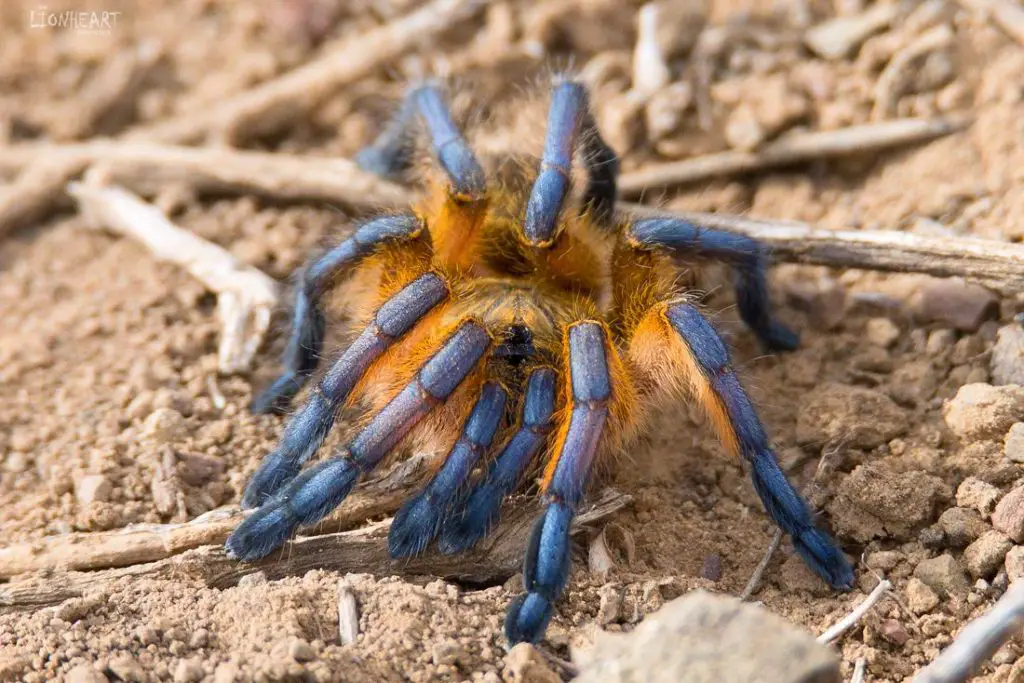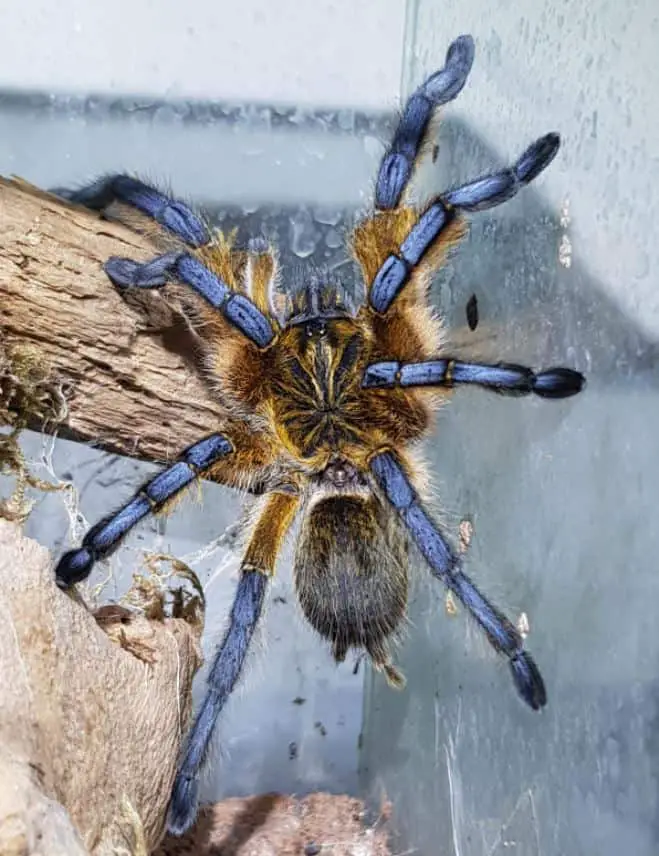The Golden Blue Leg Baboon Tarantula is an Old World terrestrial species found around the town of Makhanda, Previously known as Grahamstown in South Africa.
This spider has a fantastic color mix with classic yellow, blue, orange, and brown tones. The Golden Blue Leg baboon has a peaceful and laid-back attitude, something that is rare to find among baboon species, which makes it really popular among hobbyists who want to try their hand at raising baboon tarantulas.
If you’re thinking about getting one of these beautiful specimens, here’s everything you need to know about them.

Golden Blue Leg Baboon Tarantula Care Sheet
| Species Name | Harpactira pulchripes |
| Family Name | Theraphosidae |
| Common Names | Golden Blue Leg Baboon Tarantula |
| Category | Old World |
| Type | Terrestrial burrower |
| Native Location | South Africa |
| Body length | 2.5 inches (~7 cm) |
| Leg Span | Females 5 to 6 inches (~13 to 15 cm) / Males 3 inches (~8 cm) |
| Growth Speed | Medium |
| Urticating Hairs | No |
| Social | Solitary |
| Diet | Insects: primarily crickets and roaches |
| Temperature | 70 to 75 degrees °F |
| Humidity | 60 to 70% |
| Lifespan | Female: 10 to 12 years / Male: 2 to 3 years |
| Experience required | Intermediate |
| Minimum tank size | 3 to 5 gallons. Horizontal space > Vertical space |
Golden Blue Leg Baboon Overview
The Harpactira pulchripes, better known as The Golden Blue Leg Baboon (GBLBT), is a terrestrial baboon tarantula.
Contrary to most baboon spiders, which tend to be quite defensive, the Golden Blue Leg Baboon is known to be more docile. In addition, it’s known for having a beautiful coloration, and it tends to stay on display most of the day on its web.
At the same time, it’s still a baboon tarantula, so its venom can be quite significant. It’s not recommended as a tarantula for beginners.
However, if you’re proficient with basic tarantula care, or have had one or two New World Tarantulas in the past, it becomes a good choice for keepers trying to initiate with Old World Tarantulas since they require little maintenance and are less defensive than some of the other Baboon species.
Appearance & Variations

The Golden Blue Leg Baboon has been a stunner since her discovery. She has a beautiful blue metallic tone on the distal two-thirds of her legs. The tarantula also displays a yellow almost-golden coloration over her cephalothorax and abdomen. This golden yellow is mixed with the typical dark markings you’d see in baboon tarantulas.
Some specimens have orange coloration and darker legs instead of the yellow tone, especially at earlier stages right before a molt; however, some keep them into adulthood.
These spiders exhibit sexual dimorphism. Males are usually smaller and not as blue as females. Males typically grow to a maximum size of about 3 inches, whereas females can reach double that size at 6 inches.
Price
The price for a Golden Blue Leg Baboon varies depending on whether you buy a male or a female, but it’s on the cheap side compared to most spiders.
An unsexed or adult male can be bought for as little as $50 to $60.
Meanwhile, females can be purchased for $100 to $200 in some cases due to their size, more stunning coloration, and longevity.
Behavior and Temperament
The Golden Blue Leg Baboon is a terrestrial burrower. It likes to stay hidden inside her burrow most of the time during its early stages of development.
Once the tarantula grows into adulthood, she starts webbing over her burrow and tends to spend more time in the open. Some adults will even spend all their time outside their burrows, preferring to remain in the webs instead; it’s perfectly natural behavior for them.
The Golden Blue Leg Baboon Tarantula is mostly described as a laid-back and quite visible tarantula, which is very unusual when compared to other baboon species. This, combined with the fact that they’re a very colorful species makes them excellent as display spiders.
However, she may be relatively peaceful, but she’s not afraid to assume a threat posture if she feels cornered, which is an indication that she might bite.
In these cases, your best course of action is to retreat as soon as possible; their venom is very painful, so it’s better to be safe than sorry.
Caring for a Golden Blue Leg Baboon Tarantula
Temperature and Humidity
The Golden Blue Leg Baboon Tarantula comes from South Africa. Her natural habitat is in arid places with many dry and sunny days over the year, in areas where the temperature lies between 72°F and 82°F degrees.
Caretakers should sustain room temperatures between 70F to 75F, with humidity between 60% and 70%. Ventilation is also important.
Substrate
The Golden Blue Leg Baboon Tarantula is a burrower, so it needs enough substrate to burrow in order to feel comfortable.
Spiderlings should have at least two inches of substrate. Juveniles and adults need at least 4 inches of substrate. A mixture containing coconut fiber, peat moss, or topsoil will be great for them, it’s soft enough to burrow, and is good at retaining moisture.
Tank
The Golden Blue Leg Baboon needs a fossorial setup, so a 3 – 5 gallons tank should be enough for the substrate as long as their terrarium emphasizes horizontal over vertical space.
This tarantula needs places to hide, so artificial plants and a piece of cork bark are a must.
Adding moss, rocks, and artificial leaves will also help as the spider will use these as construction points for her webs.
Watering
The Golden Blue Leg Baboon Tarantula is used to dry environments, so keeping her hydrated is no challenging task. Keep the water dish away from the webs and refill it frequently with fresh water.
Social
The Golden Blue Leg Baboon is not a social creature. There were attempts to house them communally, but those ended in disaster. If you want to keep your spider safe, make sure that you house them solitarily because a communal setup will end in cannibalism.
Molting
Your spider will molt quite frequently when they’re young. They have to do this because their exoskeleton is not flexible and can not grow as the spider gets bigger. As a result, they shed it to make way for a bigger one.
If your tarantula stops eating, they’re most likely in pre-molt and will start the molting process soon. While they’re molting, do not disturb them.
Once the molting has been completed, do not feed them for several days as they will need time for their fangs to harden.
Diet & Feeding
The Golden Blue Leg Baboon Tarantula is known for her voracious appetite.
Spiderlings can be fed with flightless fruit flies, chopped pieces of mealworms, or cricket legs twice a week.
They’ll become more independent once they’re juveniles, and will be able to eat live insects. At that point, one to two medium crickets a week is enough to keep them happy.
Once they mature into full-grown adults, three to five crickets every seven to ten days will be enough.
The abdomen of a Golden Blue Leg Baboon won’t turn plump when they’re overfed. Instead, they exhibit lethargic behavior. So make sure to look out for these signs and reduce portions to avoid overfeeding them.
Lifespan & Health
The Golden Blue Leg Baboon Tarantula has a relatively long lifespan. Females can live for up to 12 years, while males typically live for 2 to 3 years.
In captivity, it’s quite easy to get them to live out their full lifespan. The only threats to them are falls, bacterial growth, parasites, and spider mites.
To avoid disastrous falls, make sure that their enclosure is not too tall and that you do not handle the spider.
To avoid bacterial growth and spider mites, make sure that you remove uneaten food, keep their enclosure clean, and have adequate ventilation in their tank.
To prevent parasites, make sure that you only feed them captive-bred insects.
Golden Blue Leg Baboon Tarantula Facts
- When the Harpactira pulchripes was discovered and imported to the U.S in 2012/2013, their price was over $500 due to their rarity.
- If you’re a hobbyist in South Africa, the local government prohibits you from having a specimen of this spider.
- Females have been spotted with older slings still congregating around them. This discovery made many speculate about its viability as a communal spider. After many failed attempts, the idea was dismissed as a failure.
Final words
The Golden Blue Baboon Tarantula lies at the top of favorite spiders for most Old World keepers. Due to their relatively docile nature, they’re a great introduction to Baboon spiders for people who already have some experience with more docile New World species.
Now that they’re bred worldwide and their price has decreased, there’s no reason to forego having one in your collection if you think you’re ready for them!
- How Long Do American Eskimo Dogs Live? Important Factors and Care Tips - September 29, 2023
- Do American Bulldogs Need Grooming? Essential Tips and Care Guidelines - September 29, 2023
- Do Bengal Cats Enjoy Playing? Essential Tips for Keeping Them Active - September 29, 2023